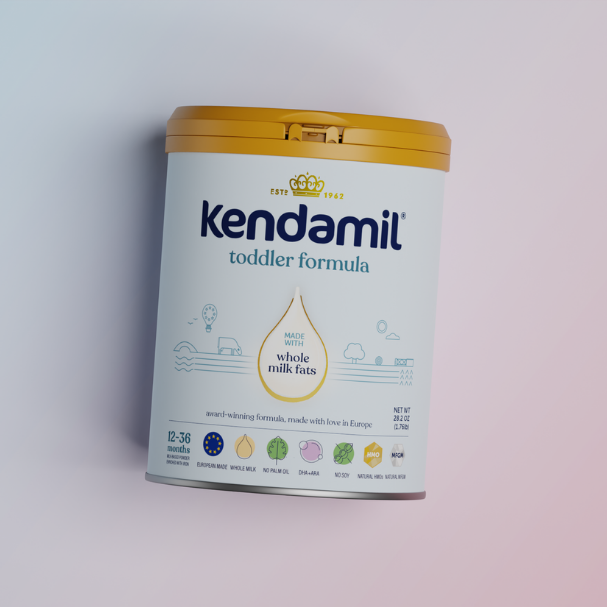Combination feeding is when you feed baby both breast milk and formula milk, and can be a great option for those families seeking an alternative to exclusively breastfeeding. There are many reasons why a parent might choose to combination feed; these could be due to healthcare reasons, low milk supply, getting Dad and other carers involved, or even going back to work. We understand that changing your little one’s diet can be a daunting prospect. So, we’re here to help make that transition a little easier.
If you feel that you need extra support to formula feed, be sure to notify your healthcare professional. They can offer medical advice and support during this transition.
Will combination feeding affect milk supply?
This is by far the biggest concern when it comes to combination feeding, and the short answer is - yes. It’s really important to be committed to combination feeding to ensure it is sustainable, and that your supply remains consistent.
Breastfeeding works on supply and demand, so if you do start to supplement with formula, this can signal to your body that you don't need to produce as much milk. This is especially important to remember if you are looking to replace feeds and don't continue to express milk in place of the formula feeding session. It’s key to understand that if you wish to continue with combination feeding, each bottle feed that replaces a breastfeed will need to be expressed to ensure supply stays consistent. Check out the USDA WIC Breastfeeding Support blog on how to express breast milk here. Breastmilk can be stored in the refrigerator for up to 4 days and in the freezer for up to 6 months - for more information on storing and thawing breast milk click here.
How to introduce formula feeds if you only express breast milk
When it comes to deciding on how to introduce a combination of formula milk and breast milk, the top-up method is a great place to start. If you’ve already expressed your breast milk, you could give your baby a bottle of breast milk first, followed by a top-up of formula. Many parents do this and this means you can make sure your baby drinks all of their mother’s breast milk for the day, with the remaining feeds being formula milk.
Lastly, if you know that you’re going to be away from your baby in the next few weeks, try practicing combination feeding a few weeks in advance. This can help to ease your baby into their new routine.
How to introduce formula feeds if you exclusively breastfeed
First, remember to be patient with yourself. This process is new, and can take a little time to get right! If you only breastfeed and want to start bottle-feeding with formula, it’s important to give your body time to adjust and to do this gradually.
It's totally normal for your breasts to feel full and possibly uncomfortable if you start swapping breastfeeding sessions for bottles. To avoid any discomfort and prevent clogged ducts, it's a good idea to express any milk you would have otherwise given during those feeds. This not only helps relieve the pressure but also keeps your milk supply steady. So, think of it as a win-win situation for both you and your baby!
It can take as long as 5-7 days for your body to adjust to a missed feed! Be sure to massage your breasts If you start to experience engorged breasts, or clogged ducts, to keep your milk flowing and prevent any unwanted illnesses like mastitis. If you are struggling with any symptoms or discomfort, be sure to contact your healthcare provider.
Top tips to help your baby combination feed
Here are some helpful tips for tackling the transition to a new feeding routine for both you and your baby. By implementing these tips, you can help ease the adjustment for both you and your little one as you navigate this new feeding journey together!
- When introducing a bottle for the first time, make sure your baby is relaxed. If they're fussy or hungry, it might be challenging for them to adapt to a new feeding method, especially if they're used to breastfeeding.
- Consider having someone other than yourself feed the bottle. Babies have a strong sense of smell and can detect your breast milk if you're nearby. Being out of the room while someone else feeds the bottle can help your baby adjust.
- Experiment with different feeding positions. Holding your baby in a different way than usual during bottle feeding can help them get used to a new feeding method.
- Try out various types of bottle nipples. Your baby may have preferences for certain shapes, sizes, or textures, so exploring different options can be beneficial.
- Prioritize skin-to-skin contact as much as possible. This not only strengthens the bond between you and your baby but also provides comfort during feeding, which can be particularly helpful during this transition period.
Which breastfeeds should I stop first?
When you're ready to phase out breastfeeds, deciding whether to cut out daytime or nighttime sessions can be a tough call. It's totally your choice, but consistency is key to helping your body adapt to the change. For instance, if you're a morning breastfeeding fan, consider shifting to formula feeds later in the day. Your miraculous body will actually sync up with your routine, so expect your milk supply to naturally dip in the evenings—like clockwork!
Remember: combination feeding doesn’t mean you can’t bond with your baby 💙
When you're making the transition to formula feeding, it's completely natural to wonder about maintaining that special bond with your baby. But fear not, because bonding opportunities are still abundant! In fact, this shift in feeding method can open up new avenues for connecting with your little one.
The magic of skin-to-skin contact isn't just reserved for breastfeeding moms; formula-feeding parents can absolutely do this too. Whether it's cuddling your baby against your bare chest during feeding times or simply spending quality skin-to-skin moments throughout the day, this physical closeness brings comfort for both you and your baby.
Sharing the responsibility of feeding with other family members can strengthen their bond with baby; Whether it's your partner taking over the nighttime feedings or grandparents stepping in for midday snuggles and bottle feeds, these shared moments create lasting memories and deepen the familial bond.
Combination feeding is a unique journey for you and your family and should work around your family’s routine and circumstances. There are many ways to tailor your combination feeding routine as we’ve covered above. Plus it’s a great way to allow you to continue offering your baby breastmilk. If you’re worried about finding the right routine for you, why not consider reaching out to a lactation consultant in your area or a breastfeeding support group - see our resources below.
If you’re looking for a formula to compliment your breast milk on your combination feeding journey then check out our formula ranges here. We have our Classic formula, our Organic formula and for those interested in a goat milk based formula we have our Goat formula. All made with love in Europe, following both EU and US standards.
Resources:
American Academy of Pediatrics (AAP): The AAP provides comprehensive information on infant feeding practices, including breastfeeding, formula feeding, and combination feeding. Their website offers articles, guidelines, and resources for parents seeking guidance on feeding their babies. https://www.aap.org/en/
La Leche League International (LLLI): While LLLI primarily focuses on breastfeeding support, they also recognize and support parents who choose to combination feed. Their website and local support groups can provide valuable information and guidance for parents navigating combination feeding. https://llli.org/breastfeeding-info/mixing-milk/
Your Pediatrician or Healthcare Provider: Your child's pediatrician or healthcare provider is an invaluable resource for information and support on combination feeding. They can offer personalized advice, address any concerns you may have, and help you create a feeding plan that meets your baby's needs.














